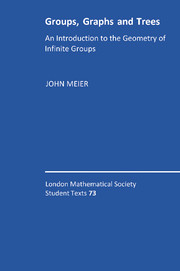Book contents
- Frontmatter
- Contents
- Preface
- 1 Cayley's Theorems
- 2 Groups Generated by Reflections
- 3 Groups Acting on Trees
- 4 Baumslag–Solitar Groups
- 5 Words and Dehn's Word Problem
- 6 A Finitely Generated, Infinite Torsion Group
- 7 Regular Languages and Normal Forms
- 8 The Lamplighter Group
- 9 The Geometry of Infinite Groups
- 10 Thompson's Group
- 11 The Large-Scale Geometry of Groups
- Bibliography
- Index
2 - Groups Generated by Reflections
Published online by Cambridge University Press: 05 June 2012
- Frontmatter
- Contents
- Preface
- 1 Cayley's Theorems
- 2 Groups Generated by Reflections
- 3 Groups Acting on Trees
- 4 Baumslag–Solitar Groups
- 5 Words and Dehn's Word Problem
- 6 A Finitely Generated, Infinite Torsion Group
- 7 Regular Languages and Normal Forms
- 8 The Lamplighter Group
- 9 The Geometry of Infinite Groups
- 10 Thompson's Group
- 11 The Large-Scale Geometry of Groups
- Bibliography
- Index
Summary
So, my interest in symmetry has not been misplaced.
–H. S. M. Coxeter (upon learning that his brain displayed a high degree of bilateral symmetry)Let a and b be reflections in parallel lines in the Euclidean plane (as in Figure 2.1). If we think of the line of reflection for a as being x = 0 and the line of reflection for b as being x = 1, then we may express a as the function a[(x, y)] = (-x, y) and b as b[(x, y)] = (2 - x, y). It follows that ab[(x, y)] = (x - 2, y) and ba[(x, y)] = (x + 2, y). Moreover, for any n ∈ ℝ, (ab)n is a horizontal translation to the left through a distance of 2n and (ba)n is a horizontal translation to the right through a distance of 2n. Thus the reflections a and b generate an infinite group.
If the two lines of reflection actually met, at an angle of π/n, then the group generated by a and b would be the dihedral group of order 2n, and the product ab would be a rotation through an angle of 2π/n. Thus the group we are considering is something like a dihedral group, except that the two reflections generate a translation, not a rotation. As the group generated by two parallel reflections is infinite, it is referred to as the infinite dihedral group, denoted D∞.
- Type
- Chapter
- Information
- Groups, Graphs and TreesAn Introduction to the Geometry of Infinite Groups, pp. 44 - 53Publisher: Cambridge University PressPrint publication year: 2008



